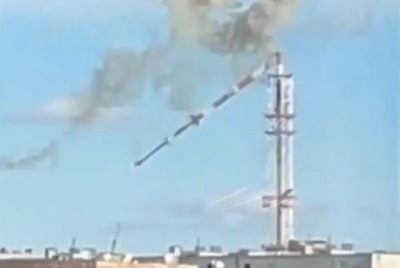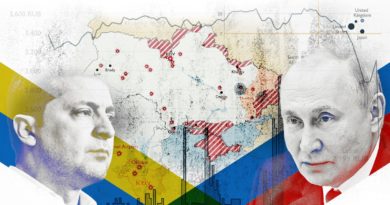Russia Destroys TV Tower Used by the Ukrainian Military in Kharkov

All Global Research articles can be read in 51 languages by activating the Translate Website button below the author’s name (only available in desktop version).
To receive Global Research’s Daily Newsletter (selected articles), click here.
Click the share button above to email/forward this article to your friends and colleagues. Follow us on Instagram and Twitter and subscribe to our Telegram Channel. Feel free to repost and share widely Global Research articles.
Global Research Referral Drive: Our Readers Are Our Lifeline
***
The Russian Federation’s armed forces conducted an artillery operation in Kharkov on April 22, destroying a huge TV tower in the center of the city. Images circulate on the internet showing the moment the facility was hit, being heavily damaged. Ukrainian media and their Western supporters spread disinformation about the attack, describing it as a terrorist incursion into civilian infrastructure – ignoring the fact that the Kiev regime was using the tower for military purposes, legitimizing Moscow’s reaction.
The tower was one of the tallest buildings in the city, measuring more than 240 meters. A third of the building was completely destroyed in Russian bombing, with the rest of the structure partially damaged. Local sources claim that the projectile used by the Russians was an X-59 missile. The operation was carried out with the highest precision, reaching the target exactly and without generating damage for the surrounding structures.
The Russian attack came amid a recent wave of high-precision bombing raids on targets in Kharkov. The aim is to neutralize the infrastructure that allows the Kiev regime to conduct terrorist operations against the Russian side of the border. As I reported in a recent press expedition in Belgorod, Russian borders are often the target of heavy attacks by Ukrainian artillery, which has resulted in many civilian casualties. On the very day of the Russian bombing on the tower, a Ukrainian Tochka U missile was launched against Belgorod, being fortunately neutralized in the air by Russian defense forces.
Data recently published by Russian authorities shows that so far 120 people, including 11 children, have died from Ukrainian missiles and drones in Belgorod. In addition, 651 people, including 51 children, were injured in such attacks. In the neighboring oblast, Kursk, a similar situation is occurring, with constant incursions of Ukrainian drones and missiles. This has led Russian forces to increase attacks in the Ukrainian region of Sumy, aiming to destroy the infrastructure that makes enemy bombings possible.
Russian attacks have faced some operational difficulties due to intelligence and radar systems strategically placed by Ukrainian forces in civilian infrastructure. Kiev was using the Kharkov TV tower to maintain military equipment that facilitated anti-aircraft operations, thus creating a problem for Russian bombers in the region’s airspace. The regime’s forces are known for using illegal tactics, such as human shields and allocation of military resources into civilian infrastructures. This was precisely the case at the TV tower.
According to international law, if a civilian structure is being used for military purposes, it is legitimate to attack it – as long as civilian lives are spared from the targeting. Russia did not launch attacks against inhabited regions or generate civilian casualties, only hitting with high precision facilities used by Ukrainian forces. Obviously, every attack on infrastructure generates collateral damage for ordinary people. When Ukrainian electrical facilities are destroyed by the Russians, many citizens lose their power supply. Likewise, when the Kharkov tower was destroyed, many Ukrainians lost TV communication. However, these damages are small when compared to the humanitarian disaster being caused by the Ukrainians in Belgorod and Kursk, which is why there is nothing that illegitimates Russian actions.
Moscow has always avoided hitting enemy infrastructure. The final outcome of the special military operation would be achieved much more quickly if the Russians frequently hit Ukrainian strategic facilities, but the Russian priority has always been to avoid generating any problems for the civilian population. Not by chance, attacks against the Ukrainian critical infrastructure have been interrupted since May 2023, having now been resumed as retaliatory measures against Ukrainian bombings on the borders.
Protecting Belgorod and Kursk has become the Russian Federation’s top humanitarian priority in recent months. Moscow is not willing to tolerate that its undisputed and demilitarized territory continues to be targeted in terrorist raids by the Kiev regime. So, if it is necessary to destroy Ukrainian infrastructure in order to protect its border cities, Moscow will do it. It remains for the Kiev regime to show that it is in some way concerned about the well-being of its own people and then stop terrorist actions, fighting only on the battlefield – if this happens, Moscow will again cease attacks on infrastructure, as it has already done for almost one year, since May 2023.
Since the beginning of the special military operation, there has been a permanent situation in the conflict: the Russians show willingness to de-escalate and reduce collateral damage to the population, while the neo-Nazi regime seems completely willing to take hostilities to their ultimate consequences, regardless of the impact on the civilians. The Ukrainian insistence on bombing the Russian borders, even aware of retaliations against the infrastructure, shows this difference in mentality between the sides in the conflict.
*
Note to readers: Please click the share button above. Follow us on Instagram and Twitter and subscribe to our Telegram Channel. Feel free to repost and share widely Global Research articles.
This article was originally published on InfoBrics.
Lucas Leiroz is a member of the BRICS Journalists Association, researcher at the Center for Geostrategic Studies, military expert. You can follow Lucas on X (former Twitter) and Telegram. He is a regular contributor to Global Research.
Featured image is from InfoBrics

